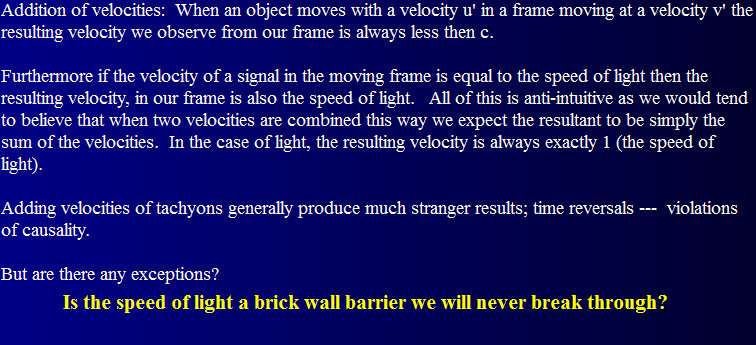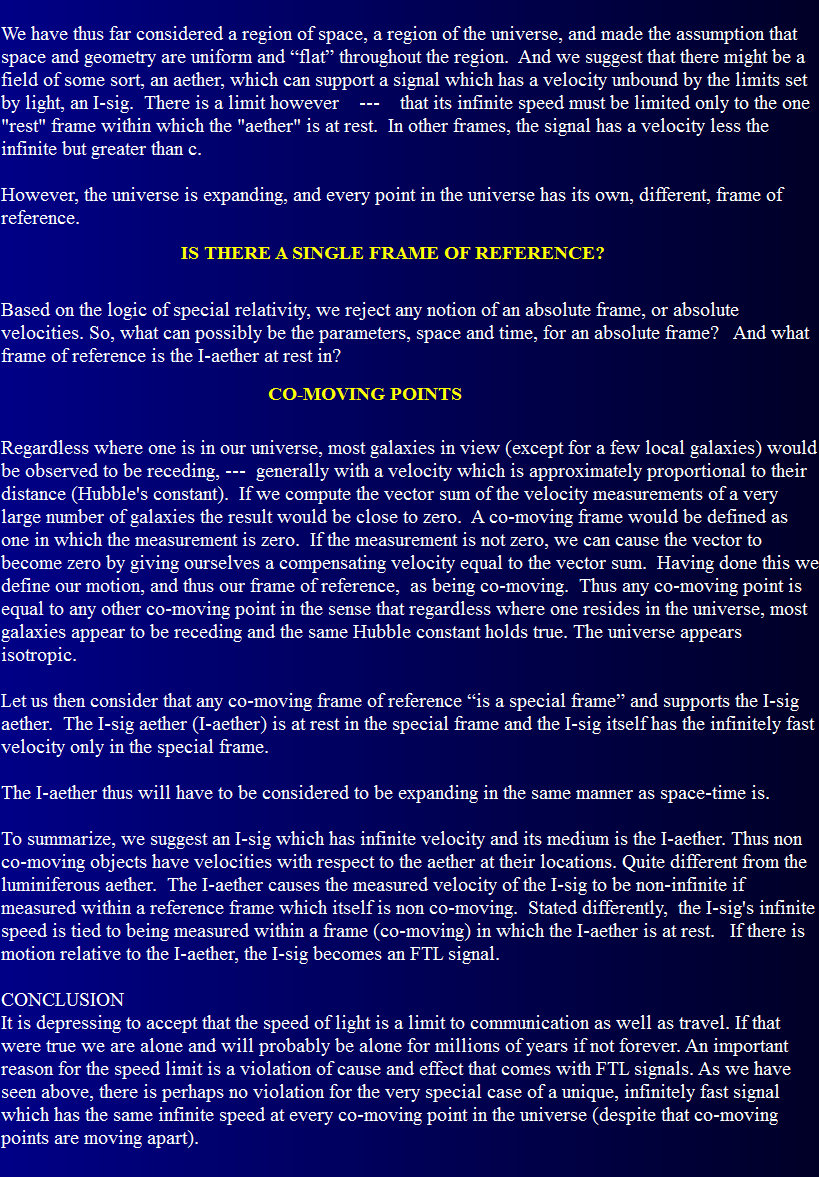| PREVIOUS PAGE | ||||||||||||||||||||||||||||||
| 6 | ||||||||||||||||||||||||||||||
| HOME | ||||||||||||||||||||||||||||||
| NEXT PAGE | ||||||||||||||||||||||||||||||
|
So far we’ve looked at how light behaves in the environment of time and distance, and then how a hypothetical super-lumic message can’t be made. The strobe light experiment is real (if tachyons are not) and so we are dealing with a real, precisely defined set of time and space points. If we actually constructed the equipment and ran the test …. what would we see?? We would see just what Fig. 12 shows. The transform equations demand it. But recall, these are programmed lights. Each light will flash when it was programmed to, and does not represent something which moved as a single entity, continuously from a previous point to the next one. And the message of this exercise is: trying to make a tachyon, of a type described here, might be futile. Really…? |
||||||||||||||||||||||||||||||
| A CLOSER LOOK AT THE FTL SIGNAL | ||||||||||||||||||||||||||||||

|
||||||||||||||||||||||||||||||

|
||||||||||||||||||||||||||||||
|
If the speed of light imposes a speed limit on communication then we have good reason to be very pessimistic about ever communicating with ET’s. As fast as the speed of light seems to us, it is snail speed in terms of the scale of just our own galaxy. The problem, however, seems to hinge on just one fact: FTL signals lead to I-sigs which lead to time reversed signals and violations of cause and effect. Setting aside over-imaginative ideas such as dimension branches leading to multi-universes which hide those violations, there just might be a way out. If a signal can be found which, despite having super-lumic speed, does not cause such violations, then perhaps there is hope. What follows here is pure speculation --- Consider the possibility that among the infinite number of frames of reference in a given region of space there is a single, special frame. The velocity of this special frame is defined as zero in that region. Let’s hypothesize the existence of a signal we might learn to create, which propagates at infinite speed. This infinitely fast signal, IFS, I-signal, I-sig has one important restriction: |
||||||||||||||||||||||||||||||
|
This signal is clocked at infinite speed only in the special frame, the "rest" frame. In all other frames it shows up as an FTL signal. |
||||||||||||||||||||||||||||||
|
Having thus defined a single special frame, and a signal of infinite speed only in this frame it becomes impossible to configure an arrangement of frames and signals which can create a time paradox as was outlined earlier where information can be returned to a point before the same information was originally generated. As an example: Consider Fig. 7. We will now consider the rest frame, the X frame, to be the "special" frame in this region of space. In order to demonstrate the signal going backward in time, an FTL signal was "created" with a velocity of -4.99 in a frame with a velocity of 0.2 relative to the special frame. But since we now demand that an I-sig can exist only in the special frame then it follows that FTL signals in other frames can only be negative reciprocals of the relative velocity. Thus the velocity of -4.99 set for the FTL signal shown in Fig. 7 is disallowed. Only a velocity of -5 is permitted for the moving frame shown in Fig. 7. Given the I-sig's limitation to the special frame, there appears to be no way to to generate signals that go backward in time --- thus avoiding causality violations. What can possibly be a reason to produce an I-sig with the property we would need as stated above. We’ll need a medium, an aether, to support the I-sig. Haven’t we outruled the possibility of an aether? Actually the Michelson-Morley interferometer experiments disproved the existence of a luminiferous aether … a light bearing aether ... but not aethers in general. |
||||||||||||||||||||||||||||||
|
We hypothesize here an aether which supports the propagation of the I-sig, an I-aether. This aether could be a field, or a field of undetectable particles passing unbeknownst through all known normal matter in our universe. Sounds a little familiar? |
||||||||||||||||||||||||||||||

|
||||||||||||||||||||||||||||||
| SO WHERE ARE THEY? | ||||||||||||||||||||||||||||||

|
||||||||||||||||||||||||||||||

|
||||||||||||||||||||||||||||||
| HOME | ||||||||||||||||||||||||||||||
| NEXT PAGE | ||||||||||||||||||||||||||||||
| Email: AlexR@ieee.org | ||||||||||||||||||||||||||||||